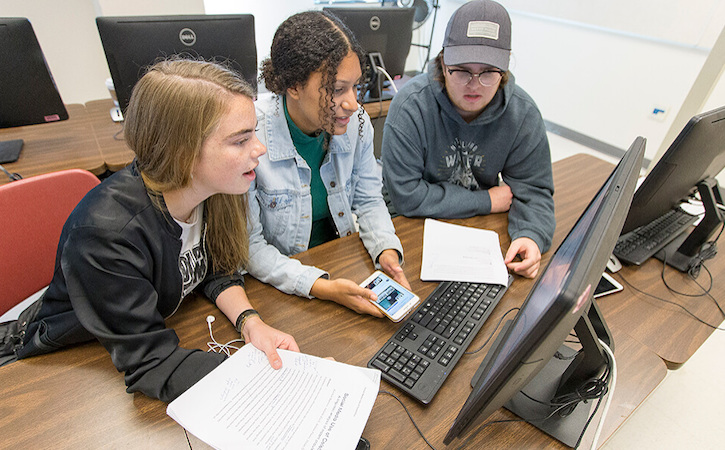New English Course Explores the Ways Digital Technology is Changing the Language

Most teachers tell students to put their phones away during class. But San Francisco State University Professor of English Language and Literature Jenny Lederer has a different approach. She wants students to look at their texts and tweets more closely … metaphorically, anyway.
This fall Lederer began teaching English 122: The Evolution of Language in the Digital Age, a new course that examines the unique linguistic patterns and processes sparked by cell phones, text messages, online chatrooms and social media sites like Twitter, Facebook and YouTube. All these new ways of communicating haven’t just made it easier to connect, Lederer says. They’re fundamentally changing what that connection looks like.
“All the extra linguistic cues you get in face-to-face communication, like facial expressions and hand gestures and intonation, we have to replace online. And there’s a lot being invented to replace that,” said Lederer. “So for a linguist it’s kind of like observing an undiscovered culture and being exposed to a language that nobody has really researched before.”
According to a recent Gallop poll, American adults under 50 are more likely to communicate by sending texts than by calling or emailing. But for some, reading an Instagram caption or opening a text message for the first time can be like trying to decipher hieroglyphics. Something like “srsly” (short for “seriously”) isn’t hard to figure out, but “fleek” wasn’t even a word five years ago, and now “on fleek” (slang for “perfect”) is already passé.
“Memes have back stories and certain emojis have back stories,” said Lederer. “There’s so much contextual knowledge and historical knowledge that goes into understanding even just one particular meme, so you really have to have that knowledge to interpret it.”
Lederer’s 25 students delved deep into their mobile devices and computer lab desktops in search of meaning, paying particular attention to the imagery and animation that digital communicators have begun using in place of text. They presented their final projects in class last week, covering such topics as how the digital language and identity of social media celebrities changes as they get more popular and the linguistic differences between Asian American and white American make-up tutorials on YouTube.
Douglas Linares, a freshman who immigrated to California from El Salvador five years ago, says that the concepts and research skills he’s learned from Lederer’s class have helped him better understand how he communicates on a daily basis.
“We were analyzing the acronym ‘lol.’ Everybody uses it, but over time it lost its original meaning,” he said. “It was supposed to mean ‘laughing out loud,’ but now people use it at the beginning and at the end of sentences and it doesn’t really represent what it used to. It’s used now to make a sentence informal.”
Linares’ group project explored the use of encoded identities in chat feeds on Twitch, a popular online video-game streaming platform. To learn more about this site, in October Lederer appeared on a panel at a Twitch conference that drew tens of thousands of people to San Jose. The panel, “The Secret Language of Twitch,” focused on emotes: emoji-like pictorial glyphs that users can place into text.
“On Twitch, fans are communicating in real time nonverbally,” Lederer said. “They’re not able to talk to each other. The only real tool they have to display their identity is through the ways they are using text and the emotes.”
By focusing on such popular, game- (and communication-) changing platforms, Lederer hopes that her class — which she wants to teach again next fall — makes linguistics relatable to today’s students. It seems to be succeeding.
“She taught us from the beginning about the basics of linguistics, and now we are semi-experts on computer-mediated communications,” said freshman Dylan O’Ryan — who’s now considering linguistics as a major.
— Ivan Natividad
Links
Photo, from left: Students Juliette Koch, Kirsten Barrow and Dylan O’Ryan work on their final project for English 122.